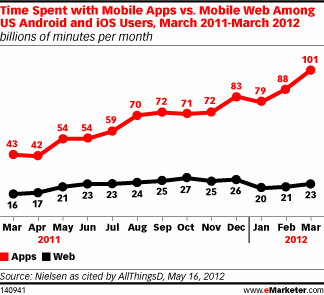If you're a marketer and you envision mobile device platforms as simply one more advertising opportunity, then you're likely going to be disappointed -- assuming that's the extent of your mobile consumer engagement strategy.
According to the latest market study by eMarketer, the mobile web and apps are like parallel highways, with distinct rules and scenery and their own versions of congestion and confusion. The more effort you invest to fully understand these differences, the more you'll benefit.
"The day may come when HTML5 matures to the point that the experience of using a web app differs little from a native app," said Noah Elkin, senior analyst at eMarketer. "Ultimately, however, focusing on the underlying technology in part misses the point about what makes apps popular."
According to Elkin's assessment, app users are drawn to the encapsulated experience that improves content delivery and draws on the hardware features of smart devices.
Consumer response in terms of adoption and use of apps is a testament to their importance within the marketing ecosystem and the central role they can play when it comes to ongoing engagement.
According to the results of a study by Nielsen, U.S. Android and iOS app users spent 101 billion minutes per month with their apps in March 2012 -- that's more than double the amount from a year earlier.
By contrast, the amount of time spent with mobile websites grew at a more modest 44 percent over the same span. Still, apps are no different than other media: The options keep proliferating but the amount of time available in a given day remains the same.
Consequently, a consumer's attention are further divided, and they respond by devoting more time to certain apps.
Overall, the top 50 apps consumed 58 percent of American user app time, Nielsen determined. On the other hand, that figure was down from 74 percent in 2011, indicating there are opportunities for new apps to capture consumer attention.
That being said, for the savvy marketers who want to fully engage a targeted mobile audience and are deciding between a mobile-enabled site or a mobile app, the essential issue they confront is "what role apps can play within the broader mobile marketing ecosystem and [in terms of] customer interaction with the brand," said Elkin.
Ultimately, any smartphone or media tablet is able to access the web -- meaning, those devices enable the marketer the ability to reach the largest potential audience. Therefore, the upside opportunity for most companies is that mobile sites and apps will likely deliver complementary, rather than exclusive, overall benefits.
